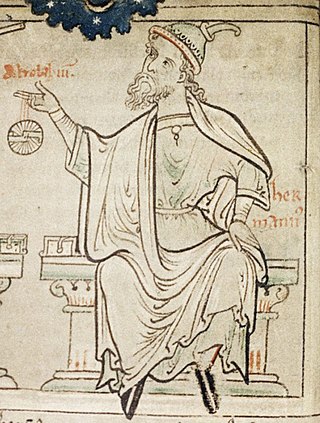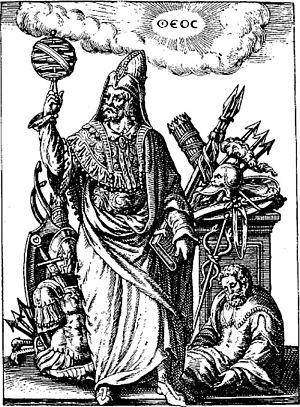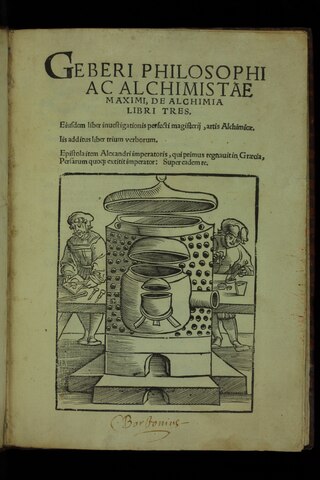The Liber Memorialis is an ancient book in Latin featuring an extremely concise summary—a kind of index—of universal history from earliest times to the reign of Trajan. It was written by Lucius Ampelius, who was possibly a tutor or schoolmaster.

Herman of Carinthia, also called Hermanus Dalmata or Sclavus Dalmata, Secundus, by his own words born in the "heart of Istria", was a philosopher, astronomer, astrologer, mathematician and translator of Arabic works into Latin.

The Hermetica are texts attributed to the legendary Hellenistic figure Hermes Trismegistus, a syncretic combination of the Greek god Hermes and the Egyptian god Thoth. These texts may vary widely in content and purpose, but by modern convention are usually subdivided into two main categories, the "technical" and "religio-philosophical" Hermetica.

Pseudo-Geber is the presumed author or group of authors responsible for a corpus of pseudepigraphic alchemical writings dating to the late 13th and early 14th centuries. These writings were falsely attributed to Jabir ibn Hayyan, an early alchemist of the Islamic Golden Age.

Michael Scot was a Scottish mathematician and scholar in the Middle Ages. He was educated at Oxford and Paris, and worked in Bologna and Toledo, where he learned Arabic. His patron was Frederick II of the Holy Roman Empire and Scot served as science adviser and court astrologer to him. Scot translated Averroes and was the greatest public intellectual of his day.

The Emerald Tablet, the Smaragdine Table, or the Tabula Smaragdina is compact and cryptic Hermetic text. It was a highly regarded foundational text for many Islamic and European alchemists. Though attributed to the legendary Hellenistic figure Hermes Trismegistus, the text of the Emerald Tablet first appears in a number of early medieval Arabic sources, the oldest of which dates to the late eighth or early ninth century. It was translated into Latin several times in the twelfth and thirteenth centuries. Numerous interpretations and commentaries followed.
Dominicus Gundissalinus, also known as Domingo Gundisalvi or Gundisalvo, was a philosopher and translator of Arabic to Medieval Latin active in Toledo. Among his translations, Gundissalinus worked on Avicenna's Liber de philosophia prima and De anima, Ibn Gabirol's Fons vitae, and al-Ghazali's Summa theoricae philosophiae, in collaboration with the Jewish philosopher Abraham Ibn Daud and Johannes Hispanus. As a philosopher, Gundissalinus crucially contributed to the Latin assimilation of Arabic philosophy, being the first Latin thinker in receiving and developing doctrines, such as Avicenna's modal ontology or Ibn Gabirol's universal hylomorphism, that would soon be integrated into the thirteenth-century philosophical debate.

Vitello was a Polish friar, theologian, natural philosopher and an important figure in the history of philosophy in Poland.

Māshāʾallāh ibn Atharī, known as Mashallah, was an 8th century Persian Jewish astrologer, astronomer, and mathematician. Originally from Khorasan, he lived in Basra during the reigns of the Abbasid caliphs al-Manṣūr and al-Ma’mūn, and was among those who introduced astrology and astronomy to Baghdad. The bibliographer ibn al-Nadim described Mashallah "as virtuous and in his time a leader in the science of jurisprudence, i.e. the science of judgments of the stars". Mashallah served as a court astrologer for the Abbasid caliphate and wrote works on astrology in Arabic. Some Latin translations survive.

Plato Tiburtinus was a 12th-century Italian mathematician, astronomer and translator who lived in Barcelona from 1116 to 1138. He is best known for translating Hebrew and Arabic documents into Latin, and was apparently the first to translate information on the astrolabe from Arabic.
Robert of Chester was an English Arabist of the 12th century. He translated several historically important books from Arabic to Latin, such as:

Latin translations of the 12th century were spurred by a major search by European scholars for new learning unavailable in western Europe at the time; their search led them to areas of southern Europe, particularly in central Spain and Sicily, which recently had come under Christian rule following their reconquest in the late 11th century. These areas had been under Muslim rule for a considerable time, and still had substantial Arabic-speaking populations to support their search. The combination of this accumulated knowledge and the substantial numbers of Arabic-speaking scholars there made these areas intellectually attractive, as well as culturally and politically accessible to Latin scholars. A typical story is that of Gerard of Cremona, who is said to have made his way to Toledo, well after its reconquest by Christians in 1085, because he:
arrived at a knowledge of each part of [philosophy] according to the study of the Latins, nevertheless, because of his love for the Almagest, which he did not find at all amongst the Latins, he made his way to Toledo, where seeing an abundance of books in Arabic on every subject, and pitying the poverty he had experienced among the Latins concerning these subjects, out of his desire to translate he thoroughly learnt the Arabic language.
Khālid ibn Yazīd, c. 668–704 or 709, was an Umayyad prince and purported alchemist.

Serapion the Younger wrote a medicinal-botany book titled The Book of Simple Medicaments. The book is dated to the 12th or 13th century. He is called "the Younger" to distinguish him from Serapion the Elder, aka Yahya ibn Sarafyun, an earlier medical writer with whom he was often confused. Serapion the Younger's Simple Medicaments was likely written in Arabic, but no Arabic copy survives, and there is no record of knowledge of the book among medieval Arabic authors. The book was translated to Latin in the late 13th century and was widely circulated in late medieval Latin medical circles. Portions of the Latin text make a good match with portions of a surviving Arabic text Kitab al-Adwiya al-Mufrada attributed to Ibn Wafid. The entire Latin text is very heavily reliant on medieval Arabic medicinal literature; and it is essentially just a compilation of such literature. It is exceedingly clear that the book was not originally written in a Latin language.

The Liber de causis is a philosophical work composed in Arabic in the 9th century. It was once attributed to Aristotle and became popular in West during the Middle Ages, after it was translated into Latin by Gerard of Cremona between 1167 and 1187. The original title was كتاب الإيضاح لأرسطوطاليس في الخير المحض Kitāb al-Īḍāḥ li-Arisṭūṭālis fī l-khayr al-maḥd, "The book of Aristotle's explanation of the pure good". Its Latin title, Liber de causis, came into use following its translation. The work was also translated into Armenian and Hebrew. Many Latin commentaries on the work are extant.
The Liber de compositione alchemiae, also known as the Testamentum Morieni, the Morienus, or by its Arabic title Masāʾil Khālid li-Maryānus al-rāhib, is a work on alchemy falsely attributed to the Umayyad prince Khalid ibn Yazid. It is generally considered to be the first Latin translation of an Arabic work on alchemy into Latin, completed on 11 February 1144 by the English Arabist Robert of Chester.

Liber physiognomiae is a work by the Scottish mathematician, philosopher, and scholar Michael Scot concerning physiognomy; the work is also the final book of a trilogy known as the Liber introductorius. The Liber physiognomiae itself is divided into three sections, which deal with various concepts like procreation, generation, dream interpretation, and physiognomy proper.

Abu Bakr Muhammad Ibn ‘Abd al-Bāqī al-Baghdadi al-Ansārī al-Kaabī (1050-1141) also known as Qadi al-Maristan, was an Arab jurist and mathematician.
Orbe is a municipality in the Swiss canton of Vaud. Orbe may also refer to:

The Kitāb al-wāḍiḥ bi-l-ḥaqq, known in Latin as the Liber denudationis, is a Copto-Arabic apologetic treatise against Islam. It was written by a Muslim convert to Christianity, Būluṣ ibn Rajāʾ, around 1010 in Fāṭimid Egypt. Its purpose is to provide a refutation of Islam on the basis of the Qurʾān and the ḥadīth (tradition). It was translated into Latin in the 13th century, probably in Toledo. It had much greater influence in translation than in its original language.













